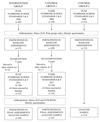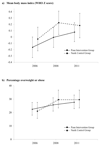Effectiveness of a 5-year school-based intervention programme to reduce adiposity and improve fitness and lifestyle in Indian children; the SYM-KEM study
- PMID: 26420732
- PMCID: PMC5389442
- DOI: 10.1136/archdischild-2015-308673
Effectiveness of a 5-year school-based intervention programme to reduce adiposity and improve fitness and lifestyle in Indian children; the SYM-KEM study
Abstract
Design: Non-randomised non-blinded school-based intervention study.
Setting: Two schools in the cities of Pune and Nasik, India.
Participants: The intervention group comprised children attending a Pune school from 7-10 years until 12-15 years of age. Two control groups comprised children of the same age attending a similar school in Nasik, and children in the Pune intervention school but aged 12-15 years at the start of the study.
Intervention: A 5-year multi-intervention programme, covering three domains: physical activity, diet and general health, and including increased extracurricular and intracurricular physical activity sessions; daily yoga-based breathing exercises; making physical activity a 'scoring' subject; nutrition education; healthier school meals; removal of fast-food hawkers from the school environs; and health and nutrition education for teachers, pupils and families.
Main outcome measures: Body mass index (BMI), waist circumference, physical fitness according to simple tests of strength, flexibility and endurance; diet; and lifestyle indicators (time watching TV, studying and actively playing).
Results: After 5 years the intervention children were fitter than controls in running, long jump, sit-up and push-up tests (p<0.05 for all). They reported spending less time sedentary (watching TV and studying), more time actively playing and eating fruit more often (p<0.05). The intervention did not reduce BMI or the prevalence of overweight/obesity, but waist circumference was lower than in the Pune controls (p=0.004).
Conclusions: It was possible to achieve multiple health-promoting changes in an academically competitive Indian school. These changes resulted in improved physical fitness, but had no impact on the children's BMI or on the prevalence of overweight/obesity.
Keywords: Obesity; Outcomes research; School Health.
Published by the BMJ Publishing Group Limited. For permission to use (where not already granted under a licence) please go to http://www.bmj.com/company/products-services/rights-and-licensing/
Conflict of interest statement
Figures
References
-
- Bhave S, Bavdekar A, Otiv M. IAP National Task Force for Childhood Prevention of Adult Diseases: Childhood Obesity. Indian Pediatr. 2004;41:559–575. - PubMed
-
- Gupta N, Shah P, Nayyar S, et al. Childhood obesity and the metabolic syndrome in developing countries. Indian J Pediatr. 2013;80(Suppl 1):S28–37. - PubMed
-
- Ebbeling CB, Pawlak DB, Ludwig DS. Childhood obesity: public-health crisis, common sense cure. Lancet. 2002;360:473–482. - PubMed
-
- Misra A, Shah P, Goel K, et al. The high burden of obesity and abdominal obesity in urban Indian schoolchildren: a multicentric study of 38,296 children. Ann Nutr Metab. 2011;58:203–211. - PubMed
Publication types
MeSH terms
Grants and funding
LinkOut - more resources
Full Text Sources
Other Literature Sources
Medical


